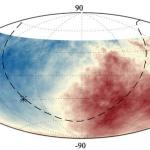Paper of the month: A long time ago in a galaxy far, far away...

The origin of ultra energetic cosmic rays has been a mystery over the past 50 years. On September 2017, the Pierre Auger Observatory reported an anisotropy in the 3 x 10^4 cosmic rays recorded with energies above 8 x 10^8 eV. This anisotropy, detected with a significance above 5.2σ, indicates an extragalactic origin for these particles; that is, they are likely to be produced far away from our galaxy.
October 24, 2017 by tiinatimonen
Physicists build powerful underground accelerators, such as the Large Hadron Collider (LHC), located in the French-Swiss border, to study particle properties with the aim of understanding the fundamental questions about matter and the Universe. Yet, the most energetic particles we have ever observed come from the sky, from sources we still know very little about.
The Earth is constantly bombarded by very energetic particles produced somewhere in the Universe. These particles, known as cosmic rays, can be electrons, protons or even heavier nuclei. Some of them can be very energetic, reaching energies of a few Joules (above 10^18 eV), well beyond the energies attained at particle accelerators such as the LHC. Where are these ultra high energy cosmic rays coming from? This question has remained a mystery for the last 50 years, and it is now closer to be solved thanks to a recent publication by the Pierre Auger Observatory collaboration, published in the prestigious Science journal [1].
The Pierre Auger Observatory, named after the French physicist Pierre Victor Auger, is the largest cosmic ray observatory ever built. Located at the western part of Argentina, it contains 1600 detectors spread over a 3000 square kilometers surface, an area thirty times the size of Paris. This huge area is one of the key ingredients for detecting very high energetic cosmic rays, since these events are extremely rare and broad -- the reason why they are also referred to as airshowers. The principle of airshowers works as follows: when a (primary) energetic particle reaches the Earth’s atmosphere, it collides with the molecules in the air and produces new particles. These in turn will also interact with the atmosphere and generate even more particles. The result of this tower of interactions is an enormous cascade of particles towards the Earth, where they can be finally detected by cosmic ray observatories.
The most recent paper of the Pierre Auger Observatory collaboration attracted the attention of the astrophysics community since it provided a first observational evidence that the most energetic cosmic rays ever observed have an extragalactic origin. By comparing the arrival direction of more than 3 x 10^4 events, an anisotropy has been found with a significance of more than 5.2σ. This anisotropy can be seen in their mapping of the sky in Fig. 1, where directions with a higher flux of cosmic rays are depicted in red. Since the anisotropy direction points in a direction with a high density of galaxies, which is not aligned with the Galactic plane, these results provide a robust evidence that the most energetic cosmic rays are indeed produced in distant extragalactic objects. The precise source has not yet been pinned down, since these particles are deflected by the magnetic fields in the Milky way, but any putative explanation of the anisotropy within our galaxy has been ruled out.
The question of where these particles come from started soon after the discovery of airshowers. Theoretical speculations already indicated that very energetic cosmic rays could not be produced in our galaxy, since theorists were unable to propose a plausible production mechanism for such particles within the Milky Way. Nonetheless, the final verdict in science always comes from experimental observations. The ones provided by the Pierre Auger observatory represent a singular step towards a final sentence for the cosmic ray origin problem.
.jpg)
Fig. 1. Color plot showing the flux of particles in equatorial coordinates. The Galactic Center is marked with an asterisk, and the Galactic plane is represented by the dashed lines. From Ref. [1].
Text by Xabier Marcano and Olcyr Sumensari
References
[1] Observation of a Large-scale Anisotropy in the Arrival Directions of Cosmic Rays above $8 \times 10^{18}$ eV.
By Pierre Auger Collaboration (Alexander Aab et al.).
[arXiv:1709.07321 [astro-ph.HE]].
10.1126/science.aan4338.
Science 357 (2017) no.6537, 1266-1270.


